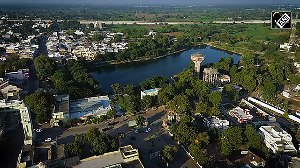Women seem to be a neglected lot in Uttar Pradesh in terms of representation in the Assembly. Since 1952 when the polls were held for the first time, Uttar Pradesh has witnessed 15 assembly elections, but if figures of the Election Commission are analysed, the average representation of women in the elected house is a mere 4.4 per cent.
From 1952 to the last elections in 2007, Congress gave tickets to 338 women candidates, highest among all political parties, which comes to 24 women nominees in every election.
Despite social restrictions, women have tried to get their share of political participation.
This could be gauged from the fact that in the last 15 assembly elections, 1,985 women tried their luck of which 826 that is 41.61 per cent contested as independent candidates.
Though its a different story that of the 826, only three managed to enter the Vidhan Sabha. According to EC data, Kudusia Begum was the first woman to win as an independent candidate from Sandila seat in 1977.
She was followed by Laljhadi, who won as an independent candidate from Gauri Bazar in 1989 and Manju, who won from Ballia seat in 1996. Going by the records of political parties including Socialist Party, Kisan Mazdoor Praja Party, Praja Socialist Party, Janata Dal, Bhartiya Kranti Dal and Samajwadi Party have till now fielded 122 women candidates.
In the parliamentary history of the state, Jan Sangh and Bharatiya Janata Party have fielded 131 women candidates, whereas Bahujan Samaj Party, which contested 1989 elections for the first time, had named 52 women as its nominees.
As per the records of the first assembly election held in 1952, out of the 2604 candidates who had contested on 347 seats, only 25 women were in fray, of which only four emerged victorious.
Thus the total representation of women in the state assembly was merely 0.86 per cent.
In the next assembly election held in 1957, 1,759 candidates were in the fray for 341 seats, with 39 women in the race of 18 elected and the representation of the fair sex in the house was 5.27 per cent.
In the preceding assembly elections, representation of women in the state assembly was 4.55 per cent in 1962, 1.41 per cent in 1967, 4.23 per cent in 1969, 4.95 per cent in 1974 and 5.41 per cent in 1977 assembly elections.
In 1980, when mid term elections were held in UP for 425 seats, 85 women candidates contested the poll of which only 23 were elected and the percentage was 5.41 per cent.
The Bharatiya Janata Party, which contested elections for the first time, gave tickets to five women, but none of them succeeded in entering the Vidhan Sabha.
In the 2002 elections, after carving out of Uttrakhand as a separate state, 5533 contestants were in the fray for 403 seats of which 344 were women.
However, out of 344, only 26 won the election and their representation was bare 6.45 in the house. In the 2002 elections, Congress gave ticket to 30 women candidates, of which only Louis Khursheed won and security deposit of remaining 29 candidates was forfeited.
In the 2007 assembly elections, of 6086 candidates, 370 women tried their luck, but out of them only 23 won and their representation was only 5.7 per cent in the House.








